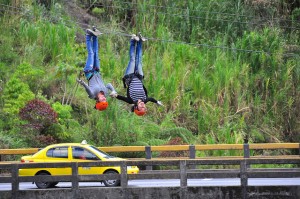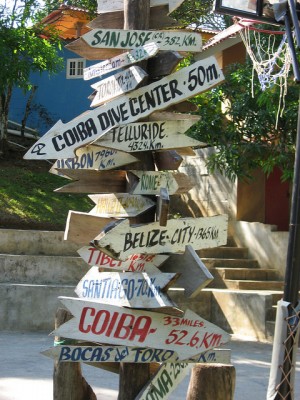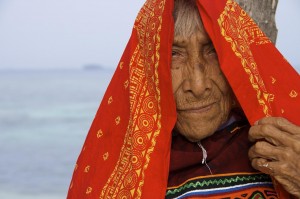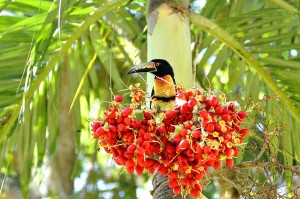
If there’s any link between immigration and economic growth, then it’s high time U.S. politicians took a page from the Panama visa playbook.
While that may sound odd, to suggest that a developed nation should take political cues from a third-world country, it makes a bit more sense when you consider the fact that Panama has posted GDP growth rates averaging around 8.5% over the past decade.
During that same time frame, the U.S. has hovered mostly between 0% and 4%, with a lovely plunge down to -8% circa 2009.
During this period of starkly contrasting economic up- and down-turns, the two nations have also seen their governments’ stances on immigration diverge in opposite directions.
Lady Liberty Is a Liar
First the U.S. Historically a nation that welcomed immigrants from troubled nations, particularly those who had something to offer the economy, the U.S. has become home to over 11 million undocumented workers, a limited number (85,000 to be exact) of work visas for foreigners, and a talented pool of international students who are having to go elsewhere to find work following graduation.
What happened to The New Colossus? “Give me your tired, your poor.” I have a feeling the ancestors of many U.S. residents are rolling over in their borrowed graves.
Oh, and despite this willing group of skilled workers, 39% of U.S. employers reported having trouble filling jobs last year, according to a survey conducted by the Manpower Group. Yet unemployment still held steady between 7% and 8%. Go figure.
Washington’s response? Uh, well, they don’t seem to have one. At least, not yet. Immigration reform is a topic that’s been debated, delayed, and avoided by politicians on both sides of the aisle. Currently, there’s still no resolution in sight.
Panama’s Predicament
Contrast this with Panama. It’s a country that hasn’t been all that hospitable to foreign workers.
Most Panamanian visas prevented immigrants from working for domestic companies, and strict labor union policies kept companies from employing foreigners to fill more than 10% of their available jobs (15% for experts and those in skilled technical roles). All in an effort to keep outsiders from taking jobs away from Panamanians.
These tactics worked,and Panama has enjoyed low unemployment rates (currently near 4%). However, it’s also been blazing a trail as one of the world’s fastest-growing economies.
In a race to catch countries like Singapore and position itself as a communications, logistics, finance hub, Panama has been a frenzy of activity. The construction of new hotels, office buildings, and housing complexes have created a demand for service and construction workers. A multi-billion dollar canal expansion alone has generated more than 30,000 jobs.
Good news, right? Well, yeah, all except for the fact that it’s a bit of a stretch for a country of only 3.5 million people that has no way of importing additional manpower with any kind of quickness.
Not to mention, many of the jobs needing to be filled couldn’t be staffed with Panamanians due to languages or other special skills needed. This kind of training could be provided, but that takes time. So do improvements to the country’s education system, although those were still implemented anyway.

Michaelseangallagher
If You Can’t Beat ’em, Find a Shortcut
Panama needed a solution fast, and President Ricardo Martinelli delivered one when he signed an executive order offering immediate permanent residency to citizens of 48 countries that “maintain friendly, professional, economic, and investment relationships with the Republic of Panama.”
Known as the “Specific Countries” or “Friendly Countries” visa, the decree created a fast track to citizenship for skilled workers who could help meet Panama’s increasing demand. Not only can they meet immediate staffing needs, they can also help train Panamanians for technical jobs and management-level positions they couldn’t have otherwise attained.
It’s quite brilliant really. Rather than fight the labor unions or create a virtual filibuster of political back-and-forth, Martinelli just handled it.
Labor unions want 90% of workers to be citizens? Well, now new residents are attending mass legalization ceremonies called “melting pots” where they’re immediately granted a work permit. They legalized over 5,000 foreign workers in April alone.
Panama is serious about sustaining its record growth and embracing the talent of skilled workers from all corners of the globe. For now, anyway.
There’s a New Sheriff in Town
A new president, Juan Carlos Varela, will take office in July of this year. It remains to be seen whether he will repeal Martinelli’s Friendly Countries visa, as is generally the custom of new incoming administrations.
The president-elect of Panama usually undertakes, as their first order of business, the act of cleaning house and replacing and reversing all the people and policies employed by the previous leader. Hopefully, though, he too has been solidly convinced by the incumbent’s actions and will leave the groundbreaking visa program as is.
The majority of the nation has taken note of the tremendous success the country has seen by acknowledging the need for a talented and diverse workforce in order to sustain its economic growth.
Now, if only Washington would follow suit.

Park Wilson, professional real estate investor, founder of Viva Tropical, Emerging Terrains and island owner joins the show. You may not know him yet, but he is Josh’s business partner and today they talk about everything you need to know about investing in real estate.
With over 30 years combined experience this is a can’t miss episode for anyone considering buying or investing in Central America.
Don’t miss this podcast/investment course on today’s show.
In this episode, we discuss:
- What makes property values increase
- How to avoid getting killed on your investment
- How to evaluate markets
- How to approach investing like a professional
- Find out how to spot appreciation
- How to control a market
- How assumptions çan kill your deal and what to do about it
And much more.
Listen to the show
You can listen to the show using the player above or grab it and listen on the go via one of the following options:
- Click here to download the mp3
- Click here to subscribe via iTunes
- Click here for the RSS feed (non iTunes)
- Click here for the show archive
React to the Show
We appreciate your reaction to episodes of Viva Radio and feedback about how we’re doing.
Send us your thoughts any time in an email or comment below.
The Show Notes
- Park and Josh’s island
- Get Pay Dirt! Our investment book free!
- Learn more about Real Estate Market Stages
- Our Panama Real Estate Listings
- Our Costa Rica Real Estate Listings
Everything you need to know that happened in the last 2 months in Ecuador.
Each day we sift through hundreds of articles in English & Spanish to bring you the very best ones from Central America. From investment indicators to new infrastructure projects. Adventure stories to politics. It’s all here.
Ecuador June 2014.

Casey
Ecuador Lifestyle
- South America Emerges As New Hub for Adventurous Expats (Emigrate UK) Ecuador is being touted as the perfect place to live the expat dream for many Americans, but watch out, those Brits are on their way as well.
- Man to Run Across Ecuador’s ‘Avenue of the Volcanoes’ (BBC News) One ultra marathon runner is going to have some hot toes when he attempts a run across Ecuador’s 100-mile ”Avenue of the Volcanoes” in just one day.
- Development on the ‘Lost City of Giants’ in Ecuador (Epoch Times) Grossly large pyramids, unknown to man, have been discovered in the remote jungles of Ecuador. Not so fast, says the government of Ecuador whose team concluded that the site was a natural formation and not man-made, ruling out any government funded excavations, or preservation of the site.

Codelco
Ecuador Economy
- Ecuador Eyes Legal Reform, Tax Incentives to Spur Mining Sector (Reuters) Big plans are in the works for Ecuador to change its mining law and offer tax incentives to attract foreign investors and spur investment. They hope to accomplish this by adjusting a windfall tax and make changes to its mining law.

Rinaldo Wurglitsch
Ecuador Tourism
- Quito, Ecuador Nominated As South America’s Leading Destination for Second Consecutive Year (Zawya) Way to Go Quito! The world’s second highest capital city, one of Latin America’s leading tourist and trade destinations, was nominated for the second consecutive year as the South American Leading Destination at the World Travel Awards (WTA) 2014.
- Hitting Ecuador’s Highlights — and History (Seattle Times) Where can a traveler find direct links to a nation’s past? Ecuador, of course, when they visit a revitalized Quito, centuries-old haciendas and famous Otavalo market nestled in the Andean mountains.
- Ecuador: Taking a Hike in the Clouds (The Province) A jungle hike through Mashpi Preserve in the Chocó cloud forest of Ecuador is like stepping back in time — a long, long time ago.

Presidencia de la República
Ecuador Politics
- Ecuador’s President Backs Indefinite Re-elections, Coy About His Plans (Reuters) How does one keep their presidential job in Ecuador? Ask Ecuador’s President Rafael Correa who is backing a constitutional change which will allow politicians to run indefinitely, potentially paving the way for the leftist himself to seek the top job again in 2017.
- Can Rafael Correa Deliver His Citizens’ Revolution for Ecuador? (The Guardian) President Correa faces tough challenges in modernizing his country’s economy and overcoming an intractable colonial legacy which divides his nation.

Josh Kellogg
Ecuador Environment
- Ecuador Becomes First Country to Undergo Innovative UNCTAD Programme to Assess ‘Green Export’ Potential (United Nations) The United Nations is taking an active role in Ecuador’s move to develop national “green sectors” that will expand exports and employment, while promoting sustainable development, in the first stage of a new programme on green export potential and policies.
- Ecuador Issues Permit to Drill In Pristine Amazon Reserve (Huffington Post) Ecuador has issued an environmental permit for oil drilling in its Amazon reserve. Two indigenous groups living in voluntary isolation inhabit Yasuni, which the U.N. in 1989 declared a biosphere reserve.
- Ecuador Declares Emergency in Galápagos Islands (Wall Street Journal Online) Ecuador has declared a state of emergency on the Galápagos Islands following a freighter accident which was carrying chemicals and dangerous products leaked toxins into the surrounding sea. Ecuador enacted the emergency in order to deal with the nearly 1,000 tonnes of pollutants the ship was carrying.
Like this country brief? Get it in your inbox weekly for free.
Be sure to catch the weekly country briefs by subscribing via email right here:

W. Farir
Costa Rica has historically been a relatively easy place to enter and live. There were no departure taxes. Income requirements for most visas were relatively low. And border officials were just as laid-back as the rest of the population.
However, in recent years a few things have changed. The minimum proof of income has increased. A border tax now exists. And officials have begun to crack down on “perpetual tourists,” as well as those who’ve outstayed their welcome.
As a result, there’s never been a better time to go ahead and get your hands on a Costa Rica visa. The legal way, that is.

Martingarri
Costa Rica Visa Options
Costa Rica offers a number of visas for those who wish to visit or reside in the country. Here are a few good options.
Tourist Visa
This one’s sort of a misnomer, as it’s really not a visa at all. Visitors from North America, as well as most other nations, don’t need to apply for a visa to enter the country. They’ll merely stamp your passport and authorize you to stay in the country for a period not to exceed 90 days.
After that you’ll need to skedaddle. Or else face a fine of $100 per month (or a proportion of that amount if you’re only days or weeks late).
Many foreigners skirt around this time limitation by taking a trip across the border once every 3 months, for at least 72 hours. Reentering the country gets you a fresh stamp granting you another 90-day stay.
Even though some expats have literally been doing this for years or even decades, it’s quite risky. You’re taking the chance that the border officials won’t notice or care what you’re doing. And while it isn’t technically illegal, it definitely isn’t the aim of the tourist visa.
Judging by the direction the government is headed with their recent changes to immigration laws, it’s entirely possible that you could be escorted out of the country and prevented from reentering for an extended period. Anyone with a home, family, or business at stake might want to consider looking at one of the other options.
Requirements: You’ll need a valid passport that doesn’t expire for at least 6 months. Other things they could (but won’t necessarily) ask you for include proof of departure (either back to your home country or to another destination outside Costa Rica) within 90 days, as well as proof that you have sufficient funds and won’t need to work to support yourself while you’re in the country (i.e. a bank statement).
While they may not ask you for either of these things, they legally COULD. So be prepared, just in case. The country has also recently implemented a departure tax ($7) at all land borders, something that was previously charged only for air travelers ($29).
There have been reports of travelers’ inability to pay this tax at the border due to technical difficulties, so a good suggestion is to pay it at a Banco Credito Agricola branch (or another designated collection point) before arriving at the immigration station. Ironically, the taxes were introduced to help fund some much-needed improvements at the border crossing facilities.
Income Potential: Those visiting Costa Rica with a tourist visa are not permitted to work during their stay.
Pensionado Visa
This one, as well as the others that follow, is an actual residency visa. It’s designed for foreigners living on a lifetime pension, such as social security, annuities, military pensions, or other guaranteed retirement benefits.
While many holders of this visa are older adults, there’s no age requirement for obtaining one. There are plenty of pensioners of all ages, including retired military personnel. Those who hold this visa can claim their spouse, as well as other dependents under 18, without increasing the income requirement.
Requirements: The basic requirements for each visa include marriage and birth certificates, as well as a certificate of good conduct from the police department in your home country. These are also required of all dependents.
All documents must be notarized, approved by the Secretary of State (or the equivalent in another country) and authenticated or apostilled (legally translated) by the Costa Rican consulate in the country where the documents were issued.
For this visa, you’ll also need to show proof of at least $1,000 in monthly income from a guaranteed source that will last throughout the pensioner’s life. This minimum amount is up from just $600 a few years ago.
You’ll need to continue to show proof of income at each annual renewal. You’re also required to enroll in the country’s government health program, called CAJA. Another stipulation is that you must live in Costa Rica for at least 4 months out of each year.
Income Potential: Those with a pensionado visa cannot be employed by a Costa Rican company, but they are permitted to own their own business and receive income.
Rentista Visa
This visa is designed for small investors, and it’s a great option for those who want to give Costa Rica a try without jumping through a lot of hoops or being bound to any long-term obligations. Its holders also have either a guaranteed source of income or, more commonly, the ability to make a sizeable deposit into a Costa Rican bank that can be disbursed over the course of 24 months.
Rentistas can also claim their spouse and other dependents. However, additional income is needed for these additional family members.
Requirements: To obtain a rentista visa, you’ll need to show proof of income of at least $2,500 per month (up from $1,000) from a guaranteed source. This is generally done in the form of a $60,000 deposit in a Costa Rican bank.
You’ll have to show proof of income (or make another deposit) after two years when the visa must be renewed. You’re also required to enroll in CAJA and live at least four months out of each year in Costa Rica. Note, these do not have to be in a continuous period for either visa mentioned thus far.
You’ll also need the required basic documents (with their appropriate authentications) as with the pensionado visa.
Income Potential: Holders of the rentista visa cannot work as employees, but they can own a company and earn income from their business.
Inversionista Visa
Tailored to large investors, this visa is similar to the rentista, but with higher deposit requirements. Spouses and other dependents may not be claimed by inversionista holders. Instead they require their own separate visa.
Requirements: The minimum investment for the large investor visa is $200,000. This amount can be invested in any business. It can also go into specific sectors approved by the government that may have their own set minimums.
In addition to the paperwork needed to document the investment, inversionista applicants will also need the same basic documents as with the previously mentioned visas.
Unlike the aforementioned visa holders, inversionistas must stay in the country at least 6 months out of the year.
Income Potential: Inversionista visa holders may earn income from their investment and/or own a business.
Permanente Visa
Anyone who’s been legally living in Costa Rica for 3 years with another type of visa or who has first-degree relative status with a Costa Rican citizen (by marrying a citizen or having a Costa Rican child) may apply for permanent residency.
It’s a great option for those who tire of continuously going through the hassle of renewing their temporary visas (although “permanent” visas also require their own form of renewal). It’s especially recommended for those who hold a rentista visa and have decided to stick around for a while. They’ll still have to renew once, but a permanent visa can eliminate that third required $60,000 deposit.
While the government makes it easy for those who marry a Costa Rican citizen to obtain residency, the immigration reforms of 2010 tightened some loopholes for those who were just marrying for convenience in order to simplify their immigration process. In short, if you’re trying to obtain residency through marriage, it had better be legit.
No spouse or dependents can be claimed under this visa, as that’s the very purpose of the visa itself. Each individual will have to go through the process himself.
Requirements: To obtain permanent residency you have to have lived in the country on another visa for a minimum of 3 years or be married to (or the parent of) a Costa Rican citizen. As a permanent resident, you’re required only to visit the country at least once a year and stay for 72 hours.
You’ll also need to prove that you’ve lived in the country for the required time limit, which can be tougher than you think.
Income Potential: Unlike holders of temporary visas, permanent residences are permitted to legally work for a Costa Rican employer. They can also own a company and receive income from any investments.

Seantoyer
Obtaining Citizenship
While permanent residency, or even a temporary visa, is often enough to meet the needs of most expats, there may be some who desire to apply for citizenship. This can be done after 7 years of living in the country as a legal resident (two years if married to a Costa Rican citizen or five years if you’re from Spain or certain Latin American countries).
Citizenship gives residents additional rights, such as the ability to vote and obtain a Costa Rican passport.
Requirements: You’ll need to show proof that you’ve lived in the country for the required 7 year (or less) period.
Also, with the exception of citizenship by marriage, you’ll have to renounce your citizenship in your former country. While this isn’t always enforced, it is technically the rule. Dual citizenship is permitted in some cases.
Income Potential: Costa Rican citizens have all the rights to seek employment or own a business, just like permanent residents.

AlphaTangoBravo
Visa and Residency Advice
As you’ve probably noticed, obtaining a Costa Rican visa isn’t always a simple process. And, with recent changes to the rules and requirements, it isn’t getting any easier.
What it is, though, is totally worth it. Holding a Costa Rican visa gives you virtually unlimited access to all the wonders in one of the world’s most beautiful countries, complete with an unrivaled quality of life, a first rate health care system, and some of the happiest people on the planet.
Our advice? Don’t try to go it alone. This is a process that is best navigated with the help of someone who specializes in visa and residency issues on a regular basis. One example is the Association of Residents of Costa Rica (ARCR).
Better yet, get yourself a good attorney who deals with immigration. Do your homework to make sure they’re credible. When your life and livelihood are on the line, that is not the time to try to save a few bucks by hiring some random bozo on the internet.
The process for many visas can take as long as a year or more to complete. Just be patient, always make sure to do everything you can to keep the ball moving forward (even when faced with obstacles), and rest assured knowing you’re doing everything you can to reach your goal.
You’ll be glad you did!
Map of Costa Rica
Costa Rica Fast Facts
- Population: About 4.8 million
- Typical temperature: Mid 80’s
- Nearest airport with U.S. flights: San Jose
- Nearest U.S. consulate: San Jose

Andrea Pignataro is today’s guest, an attorney who specializes in residency in Costa Rica. Get inside information straight from the source in this informative and ultra detailed conversation.
We discuss everything you need to know about residency from the different options to costs involved, to if you even need residency at all. You will learn what is involved in the process, what choices you have and how to hire the right professional.
In this episode, we discuss:
- If you need residency to purchase property, buy a car, or open a bank account in Costa Rica
- What type of residency is best for you or if you need one at all
- How much and what costs are involved in the process
- If you can do it yourself without an attorney
- A fee breakdown so that you know you are not getting ripped off
- What paperwork you need from your home country to apply for Costa Rican residency
And much more.
Listen to the show
You can listen to the show using the player above or grab it and listen on the go via one of the following options:
- Click here to download the mp3
- Click here to subscribe via iTunes
- Click here for the RSS feed (non iTunes)
- Click here for the show archive
React to the Show
We appreciate your reaction to episodes of Viva Radio and feedback about how we’re doing.
Send us your thoughts any time in an email or comment below.
The Show Notes
- Email Andrea or give her a call (506) 8846-0985

William Friar
Whether due to a need to supplement their retirement income or simply due to the same restless spirit that led them to move overseas in the first place, more and more expats are choosing to use their time abroad as an opportunity to begin an encore career in the tropics.
It’s a great way to experience new things and make friends in your new home. It’s also the ideal way to let your expat life pay for itself.
The idea of launching a new career in a foreign country or starting an expat business might seem daunting to some. However, with these help of these tips, the entrepreneurial expat is sure to find the right enterprise to suit his or her city and situation.

Rita Willaert
Step One: Do Your Homework.
Before you choose a business, or even a city to start it in, it’s best to find out everything you can about the area and its requirements. You’ll want to research local labor laws and employment practices. Find out what permits and licenses you’ll need.
Embassies and chambers of commerce can be helpful for this. They can also help you get referrals for credible attorneys, accountants, and other business contacts. Find out about your tax liability, if applicable, and your options for structuring your business.
Explore your visa options and make sure you won’t have any trouble finding an immigration path that will allow you to work or do business.
Step Two: Learn the Local Culture.
Doing all your research from afar is great. But there’s no substitute for actually getting your boots on the ground in your destination city so you can pick up on some of the more subtle nuances of the culture.
Talk to other business owners. Talk to local working people. Find out how difficult it is to find reliable employees and how high the turnover rate is. You’ll need to know where to find good employees and what is the best way to go about recruiting them.
You’ll also need to know what makes your employees tick. What’s important to them and what incentives will help them work to the height of their ability? What’s their idea of a satisfactory work-life balance, and how big of a commitment can you expect from them?
Even if you won’t be hiring help, it’s still important to get to know the ins and outs of the area where you’re moving. If you’ll be shipping (or receiving) products, you’ll want to know the cost and timeliness of deliveries. If working online, it’s important to consider how reliable the internet service is.
photo by William Friar
Step Three: Choose Your Venture.
You’d think this would be the first step, but oftentimes it isn’t. While some expats may know from day one that they want to open a surf school, others may prefer to be a little more strategic and make their choice of business contingent on the location they choose.
In other words, when starting a business or career as an expat, you have two options. You can either search for the best place to start the particular business you’ve always dreamed of launching. Or you can open the type of business you think might be successful in the one place you’ve always dreamed of living.
Here are some common paths expats take:
- Resume your same field overseas. There are many fields that transition easily from North to Central America. Retired medical professionals open small practices in their new city. The same goes for financial advisors and other professional services. Teachers can easily find jobs at international schools. Many workers even find they can continue their same jobs working remotely from overseas.
- Open a franchise. By opening a branch of an already established business, you can save a lot of time and headache. Chain businesses often have a proven business model, marketing strategies, and plenty of support to help you get started.
- Start an online business or website. Because of the low startup costs, Internet-based businesses are a great option for expats. Examples include consulting services, blogs, and other professional services.
- Fill a niche. Because the Latin tropics are still developing, most areas have a number of specialty product and services that aren’t available but that might be welcomed by other expats as well as the local population. You could open a wine shop, a yoga studio, or a restaurant serving up a specific cuisine the area lacks.

Delwin Steven Campbell
Step Four: Take Advice from Other Expats
When becoming an expat business-owner, there’s no better resource than other expats who have already paved the way. There’s much you can learn from their mistakes and successes. They can refer you to trusted attorneys and other professionals, advise you on business options that might not be viable, and fill you in on a number of invaluable tips and tricks.
Owning a business overseas can be rewarding on many levels. But it’s not a venture to be entered into lightly. Doing your due diligence and seeking sound advice from folks who know can help ensure that your expat life is as profitable as it is pleasurable.
Further Info
Viva Tropical founder Josh Linnes recently interviewed Patrick Vlaskovits, author of the New York Times best selling business book, The Lean Entrepreneur. They discussed this very topic and gave several great tips. Click here to learn how to start your own profitable business in paradise.

So, just how happy are you? Do you feel respected? Well-rested?
What about yesterday? Did you smile a lot? Or laugh? Did you learn or do anything interesting?
These are some of the questions participants were asked in Gallup’s recent survey, which compiled respondents’ “yes” answers into a Positive Experience Index. The survey queried residents of 138 countries and, not surprisingly, a whopping 9 out of the top 10 most positive countries are in Latin America.
Central America Dominates the Leaderboard
More specifically, of the 7 countries in Central America, 6 of them appeared in the top 11 slots. Panama took #2 with an estimated 86% of its population claiming positive emotions.
(The missing Central American nation was Belize. Only because it wasn’t one of the countries surveyed. And we’d easily argue that there are some darn positive people there as well.)
Paraguay, in South America, topped the charts for the 3rd year in a row, with 87% of respondents reporting positive emotions on the previous day. After Panama came a 3-way tie between Guatemala, Nicaragua, and Ecuador (83%) and then another tie (at 82%) between Costa Rica, Colombia, and Denmark (the only non-Latin American country in the top 10, which consistently reports high levels of happiness and well-being).
Honduras, El Salvador, and Venezuela, each of which has been plagued by political unrest and slow economic growth, came in next with 81% of their residents reporting positive feelings. The U.S. tied with 8 other countries for 19th place, at 78% positive.
Proof that Money Doesn’t Buy Happiness
What’s interesting about these results is that, while Latin America is certainly known for its laid-back atmosphere and satisfying quality of life, the region (particularly Central America) is also home to some of the world’s highest rates of poverty, murder, and social and economic inequality. Those are stats that aren’t often met with exuberance.
However, the survey’s results found that, while money does seem to influence people’s happiness levels, it’s only to a small extent. In the U.S., for example, previous research found that a higher income does impact an individual’s overall happiness, but only up to $75,000.
Beyond that amount, income seems to have little effect at all. In fact, the population least likely to report positive emotions was that of Singapore (36%), one of the wealthiest and most developed nations in the world.
So it would appear that some of the most prosperous nations in the world can also be some of the most unhappy ones. While those whose residents live in the depths of poverty bask in positivity.
Is It All a Facade?
You may be tempted to ask, as many critics already have, whether Latin America reports more positive emotions merely due to a cultural tendency to hide behind a smile and try to focus on the positive. It’s possible, as the region does seem to generally try to avoid negative statements regardless of their true feelings.
This naturally positive outlook could easily cause them to respond to these, or any, types of questions in a more favorable way than some of their counterparts. A valid point, but you’d have a hard time making a case for why that’s a bad thing.
Contrast this with countries like Iraq, Afghanistan, and Haiti where feelings of unhappiness are what’s socially acceptable. Or Armenia, for example, whose residents feel ashamed about positive experiences such as success.
Other critics claim that Latin Americans, while unarguably positive, are perhaps just emotional in general. This is evidenced by the fact that they also scored the second highest as a region (after the Middle East) in negative emotions.
Sure they laugh a lot, but they also claim to experience a considerable amount of emotions such as anger and worry. In response to this polarization, some Latin Americans agreed that the findings merely highlighted their culture’s habit of focusing on positive elements like family, friends, and religion despite leading day-to-day lives that can often be incredibly challenging.

Funky Tee
What Latin Americans Have to Say About the Results
Nothing explains the survey’s findings better than the words of the respondents themselves. Take the 33-year-old businessman from wealthy Singapore who said the following about his outlook on life:
“We work like dogs and get paid peanuts. There’s hardly any time for holidays or just to relax in general because you’re always thinking ahead: when the next deadline or meeting is. There is hardly a fair sense of work-life balance here,” he said.
Compare this to a 30-year-old surfing instructor in Guatemala, a country that barely ranks higher than Iraq on the U.N.’s Human Development Index, which measures factors like education, life expectancy, and per capita income.
“In Guatemala, it’s a culture of friendly people who are always smiling. Despite all the problems that we’re facing, we’re surrounded by natural beauty that lets us get away from it all.“
Perhaps no one said it better than the street vendor in #1 ranked Paraguay who wasn’t discouraged at all by the country’s tough economic conditions.
“Life is short and there are no reasons to be sad because even if we were rich, there would still be problems. We have to laugh at ourselves.”
It’s true that much of Latin America has struggles that first-world countries know nothing about. But this data proves those difficulties are doing little to get them down.
And if putting on a smile and facing one’s troubles with the world’s documented most positive outlook is wrong, then we don’t want to be right.
There is no denying that Nosara Costa Rica, in particular Playa Guiones, is a popular place for expats to stop and rest their traveling feet.
Exactly why has this beautiful area on the Northern Coast of the Nicoya Peninsula become so popular with expats?

Photo: Viva Tropical
The surf is consistent, easy to learn on, and fun and challenging for experts. World class yoga classes and teacher certifications are everywhere. Health food is plentiful and accessible, unlike many other parts of Costa Rica and Central America. International schools with excellent academic and cultural programs are available for those with children, making it a great place to raise a family. It is a safe community without a drug culture, unlike many other beach towns in Costa Rica. The beaches are some of the most beautiful in Costa Rica and easy to explore by foot, bus, or car. It has many of the luxuries from home making a transition towards living there relatively easy.
With all of that, what more could an expat ask for?
Surfing for All Levels in Nosara Costa Rica
Playa Guiones, a popular beach town in Nosara, has some of the most versatile surfing in all of Costa Rica.
Close to the beach there are rows of clean white water, which are perfect for beginners. In the town of Guiones several surf schools including Kaya Sol and Coconut Harry’s. Board rentals are everywhere for those looking to practice on their own. Slightly further out is a break for intermediate surfers where they can easily practice turns. On the outside big waves that will challenge seasoned surfers.
Another great thing about Playa Guiones is that the waves are surfable at any tide level, which means practicing and learning to turn is possible at any time of the day.
Playa Pelada, a short walk from Guiones, has a volcanic reef point break that is a great option when Guiones is too windy to surf.
The Nosara Rivermouth, about a mile north of Playa Pelada, is not at all crowded likely because it is the most challenging break in the Nosara area. The Rio Nosara empties into the ocean and the rocky break produces some of the best waves in the area. The waves are for intermediate to advanced surfers only.
For those with a car tons of nearby beaches have incredible waves for you to explore including Ostinal, with heavy hollow breaks, and Playa Marbella with hollow but softer waves.
Nosara Offers World Class Yoga
The Nosara Yoga Institute not only put Nosara on the map as a popular travel destination in Costa Rica, it put Costa Rica on the map as a popular place to practice yoga. For years the NYI has offered world-class yoga classes and teacher trainings. Sitting up on a hill in the forest, the NYI is a peaceful, intimate place to practice whether for one afternoon, during a week long retreat, or for a month long teacher training.
Following the Nosara Yoga Institute’s lead, several studios now exist, offering incredible drop-in classes and teacher trainings. The Harmony Hotel hosts a lovely space tucked in the garden across from a pond with twice daily classes taught by many of the same teachers as classes at Nosara Yoga Institute.
Blue Spirit yoga is another popular spot that offers yoga and meditation retreats and Yoga Teacher Trainings.
Unique styles of yoga difficult to find elsewhere are in Nosara including 5 Rhythms Dance, which is a type of moving meditation and aerial yoga where yogis practice their asanas while suspended.
It is not uncommon to see groups practicing yoga on the beach and you may feel inspired to get playful with some acro yoga.
Pilates courses are also available at Pilates Nosara which offers daily drop-in classes, workshops, retreats, and teacher trainings.
Nosara’s Health and Wellness Culture
In harmony with the spectacular and plentiful yoga there is a very dedicated health community in Nosara.
Playa Guiones has one of the only organic grocery stores in Costa Rica. Organico Deli-Market has organic produce daily, healthy staples like bee pollen and quinoa, a bulk spices, nuts, and dried fruit section, local cheeses and other goodies, and delicious ready made soups, salads, and sandwiches.
Every Saturday from 8 a.m. to 1 p.m. is an organic Farmer’s Market selling organic meat, fruit and veggies, and homemade bread and pastries.
Naked Foods, also in Playa Guiones, has an incredible healthy juice and snack selection. Amazing juice combinations like coconut water, ginger, cayenne, cucumber and honey are bottled and available from their cooler. They sell glass jars filled with dehydrated bananas you can top with incredible cacao butter, spirulina fruit snacks, and other raw goodies. Jars of fresh spices are also for sale.
Most of the yoga studios offer body work, as does Tica Massage, further supporting your wellness transformation.
Nosara Is a Great Place to Raise a Family
With two private schools with international students, Nosara is a great place to raise your children. The schools have small class sizes, a diverse curriculum, and are taught bilingually to teach your children Spanish while continuing to cultivate their command of the English language. Because the schools are international, kids learn not only about Costa Rican culture, but about the many different cultures of the other students in their classes.
Del Mar Academy has a summer program that lasts only a couple of months for families looking to test out the area.
It is also full of fun activities for kids. Aside from playing at the beach and exploring the jungle, there are surf lessons safe for kids of all ages, yoga classes for kids, and boxing, ballet, swimming, and tumbling classes.
The many other expat families who have already chosen to call Nosara home make this community very family centered. It is easy to meet other families in Playa Guiones simply shopping at the market, eating in a café, or playing at the beach because it is such a small town.
Bringing your children closer to nature is a great reason to move in Nosara. In this small town in the jungle it is not uncommon to interact with wildlife daily. Howler monkeys, lizards, and beautiful birds are as common to see as squirrels and pigeons in North American cities.
Nosara Is Safe
When deciding to live abroad, safety is often a concern. Nosara is known to be one of the safest beach towns in all of Costa Rica. Because it is a small community, everyone looks out for one another keeping the town protected. Playa Guiones and the surrounding beach towns have a complete lack of party scene, which means no drug culture or scene. This keeps most unsavory individuals and activities away which contributes to a very low crime rate.
Expats and locals will tell you it is completely safe to walk at night all over Playa Guiones.
It Is Beautiful
Nosara spans over several beaches that have dramatic rocky cliffs, tropical palm trees, and big expansive sand shores. Walking from one beach to another you see how beautiful this area truly is.
A short drive from Playa Guiones is San Juanillo, with clear water and white sand. Beachcombing is excellent with incredible shells all over the shore and the water is clear and calm enough for some snorkeling around the nearby rocks.
Between June and December it is possible to see one of the most incredible sights in all of Costa Rica at the Ostinal Wildlife Reserve less than a half hour from Playa Guiones. Thousands of sea turtles run onto the shore to lay their eggs and in later months you can see these eggs hatch and make their pilgrimage out to sea.
It is undeniable that watching the sun set over the ocean and the sky light on fire is one the most incredible sights in the world. Overlooking the Pacific Ocean, Nosara has some of the most beautiful sunsets anywhere. So much so that watching the sunset is a daily community activity in Playa Guiones. Surfers come in from their session, families perch on the hill, travelers and expats sit in silence for an hour to watch the descent of the massive orange sun.
It Is an Easy Transition
Compared to the rest of Central America, Costa Rica can feel very North American. Compared to the rest of Costa Rica, Nosara feels particularly North American. In fact, at times Playa Guiones may feel like a small California beach town. This makes transitioning into life abroad much easier.
Restaurant workers, hotel staff, and shop clerks all speak English and many foods we are accustomed to in North America, like health food, pizza, and fusion, are all available in Nosara. High end hotels like The Harmony Hotel and other retreat centers offer many first world luxuries.
That said, it is entirely possible to have an authentically Costa Rican experience here. If you desire to, locals will speak Spanish with you. There are also Costa Rican style cafes. However, if you long for some of the comforts from home, they can certainly be found in Nosara which can make taking the leap a lot less scary.
If you’re a would-be expat who has your sights set on an island destination, then it’s likely Roatan, Honduras, has found its way onto your radar. It’s relatively inexpensive, yet offers a well-developed tourist infrastructure.
And, hey, if some of the globe’s top cruise lines have added Roatan to their list of stops, then surely there must be something there worth seeing, right?
Roatan is great, and its recent spike in popularity has certainly been warranted. But just in case you’re looking for a little less tourist traps and a little more authentic island atmosphere, let’s see how it stacks up against Boca Chica, Panama.

Viva Tropical
Round #1: Accessibility
Winner: It’s a Tie
Thanks to recent and coming improvements in both countries’ transportation options, you’ll find both of these islands incredibly easy to get to. Roatan, Honduras, is now accessible via direct flights from several major U.S. cities, such as Houston, Miami, and Atlanta.
You can basically hop on a plane and be there in as little as 2 hours. Not too shabby. This is a drastic difference from a few years ago when the only way to get to the island was via a ferry to the island or a separate domestic flight from the mainland.
Similar improvements are soon to come to fruition in Boca Chica as well. While Panama is also already accessible by way of a short international flight, Panama City has historically been the only option for arrivals.
That’s about to change when David’s Enrique Malek International Airport opens its runways to flights from the U.S. and other nations for the first time. Once you land, it’s only a 30 minute drive and a 10 minute boat ride and you’re on an island archipelago that feels more like you’re hours from civilization.
So, while Roatan is a slightly quicker trip (for now, anyway), Boca Chica stomps its Honduran counterpart in terms of access to other nearby destinations. If you need something that you can’t get on the island, you have to take a 90 minute ferry ride to the mainland.
Boca Chica’s islands require only a quick trip in a motorboat. Once on land, there are a ton of options for everything from shopping and dining to getting your boat repaired or picking up your dry cleaning. You can also explore nearby places like Boquete, Volcan Baru, and other popular tourist attractions in the Chiriqui province.
Round #2: Consumer Goods and Services
Advantage: Boca Chica
Speaking of dry cleaning and repair shops, that’s another area where Boca Chica wins out over Roatan. In Roatan you’re pretty much limited to the options available on the island. Most consumer offerings are located on the west end in places like Coxen Hole and French Harbour.
The options are decent, but the prices reflect the fact that they’ve had to be shipped over from the mainland. Plus if the island doesn’t have what you need, then back on the ferry you go.
From Boca Chica island, you can motor over to the mainland where the town of Boca Chica has enough to meet your basic needs. However, if you’re seeking something a little less common all you have to do is drive the half hour to David which is guaranteed to have what you’re looking for.
It’s so convenient that it wouldn’t be unheard of for someone to spend their day out exploring deserted islands in the archipelago, then shower, change, and head into David for a world-class steak dinner. In the city you’ll also find hardware stores, modern hospitals, government offices, and even a Mailboxes Etc.

James Willmore
Round #3: Investment Potential
Winner: Boca Chica By a Large Margin
The fact that you’re at least somewhat familiar with Roatan, Honduras, but may have never even so much as heard of Boca Chica, Panama, should be your first clue as to which has the greatest potential for appreciation.
Roatan is a well-developed tourist destination that’s been drawing international attention for a while. Boca Chica Island is a hidden gem. The mainland town of Boca Chica attracts a few tourists, mainly because of its popularity as a sport fishing mecca. But most of the islands of its archipelago are virtually untouched.
Roatan has a fair share of real estate that’s a little further off the beaten path as well, but its prices still reflect the level of development available on the island itself. Boca Chica, on the other hand, offers the same (if not better) gorgeous scenery and opportunities for adventure and exploration. But at rock-bottom prices.
Not to mention, that airport expansion we mentioned is about to cause the entire Chiriqui province, including Boca Chica, to explode. More and more travelers from all over the globe will begin visiting the area. Infrastructure will continue to improve. New businesses will open. And the result will be a tremendous spike in property values.
These projections are huge for investors.

Round #4: Atmosphere
Outcome: It Depends
Both Roatan and Boca Chica are great destinations with a really cool laid-back vibe. They also both have a good bit of variety if you’re willing to move around a bit. But each excels in a particular genre the other lacks.
In the more populated areas of Roatan you’ll find your typical Caribbean atmosphere. There are your usual tourist developments and hotels within walking distance of bars and restaurants that offer a vibrant night life.
Boca Chica doesn’t have that. There are good times to be had in Boca Chica, but they generally come in a more low-key format, like a relaxed happy hour spent on a restaurant patio.
By contrast, Boca Chica offers opportunities for complete solitude that would make even Robinson Crusoe drool. You can relax in a hammock on your private patio with nothing but your thoughts and a few howler monkeys to keep you company. Roatan has a few more secluded spots too, but they don’t compare.

Viva Tropical
Round #5: Tourist Infrastructure
Advantage: Roatan by a Landslide
Whereas Roatan has all the activities and tourist offerings you’d expect of any world-class vacation spot, Boca Chica’s options are drastically skewed towards one genre: aquatic adventures. It’s a great jumping-off spot for deep sea fishing, sailing, and other seafaring activities. For much more than that, you’ll need to venture to one of the other destinations in the province.
Roatan has a variety of options for dining, lodging, and other amenities. It’s a well-developed tourist hotspot. But that also has its drawbacks. Like the hordes of cruise ship passengers that crowd the beaches every few days or so.
It’s important to note though that Boca Chica’s relative lack of tourist offerings represents another great area that’s primed for growth. As the number of visitors to the area increase, there will be tremendous potential for entrepreneurs looking to profit by opening attractions like yoga retreats and sport fishing operations.

Michael McDonough
Round #6: Host Country
Advantage: Easily Panama
Outside of Roatan, there just aren’t a lot of expats flocking to Honduras. With the world’s #1 highest intentional homicide rate (82 of every 100,000 deaths), to say the country has a crime problem is a gross understatement.
Likewise its education system is fair, and its infrastructure is well below average for the region. You can’t drink the water, and many cities have inadequate wastewater treatment systems. Health care is also subpar, with only 57 physicians per 100,000 people.
Contrast this with Panama, whose infrastructure rivals that of first-world countries in some of the larger cities. It has good roads, reliable public transit, and some of the best internet and cellular access in all of Latin America.
There are a number of established expat communities where large numbers of English-speaking immigrants have more than paved the way for newcomers. There’s also Panama City, a bustling cosmopolitan city that many compare to Miami.
Panama’s schools are good. Its healthcare is great. It’s also one of the safest countries in the region, with less violent crimes in a year than New York City has in a day.
Panama’s government is pro-business, pro-investor, and extremely friendly to foreigners. Its pensionado program, with discounts as high as 50% on things like entertainment and travel, is the reason it’s often dubbed one of the best places to retire in the entire world.
Round #7: Snorkeling
Winner: Roatan
Boca Chica has a few private beaches where you can spend an afternoon snorkeling. Most notably there’s nearby Islas Secas, which is a 45 minute boat ride away, or Coiba National Park. It’s one of the largest marine parks in the world, but it’s a good 2-3 hours by boat.
In the waters surrounding Roatan there are over 100 diving and snorkeling sites, many of which are accessible directly from the beach. And since the island is so popular with cruisers, there are a number of outfits offering snorkeling excursions for tourists.
Round #8: Diving
Verdict: Boca Chica by a Nose
Roatan does have the benefit of being located near the Mesoamerican Barrier Reef, which reaches down to the island from Belize. As a result, it attracts many divers and is great for beginners.
However, Boca Chica lies in close proximity to a spot that offers some of the world’s best dives, according to National Geographic. Just 27 miles south is Islas Ladrones, which is teeming with schools of jack, snapper, and barracuda. There are also smaller species like surgeonfish, parrotfish, triggerfish, angelfish, and more that can be seen year round.
You can also spot several species of shark and, at certain times of the year, giant manta rays and humpback whales. Visibility near the island is 30-80 meters.
Further away, as mentioned for snorkeling, is Isla de Coiba, where you can explore a 330,000-acre reef which contains 60 of the world’s 75+ species of hard and soft coral. In these protected waters you’ll also find mullet, stingray, puffers, moray eels, and gentle sea turtles.

Snowmanradio
Round #9: Fishing
Winner: Boca Chica Hands-Down
Due to the abundance of species represented in Boca Chica, the fishing in its waters is second to none. A large majority of its tourist accommodations are comprised of fishing lodges, and the number of world record catches that were landed in and around Boca Chica is remarkable.
Most of these were snagged near Hannibal Bank, a world-famous fishing hotspot where the ocean floor rises sharply from thousands of feet deep to a mere 120 feet. Where this cliff juts out, tremendous schools of inshore fish merge with the offshore species who feed on them. Marlin in excess of 1,000 pounds and tuna over 300 pounds have been caught in these waters, as well as snapper, amberjack, and snook.
Since the island actually started as a commercial fishing hub (until tourism began to dominate), you won’t be disappointed with the fishing in Roatan. That is, unless you’ve already experienced the fishing around Hannibal Bank in Boca Chica. That’ll definitely ruin it for you.

Viva Tropical
Round #10: Land Exploration
Verdict: Boca Chica Takes the Round
Roatan has a few areas available for exploration if you’re willing to venture over to the east side of the island and get away from the more heavily touristed areas. There are botanical gardens and nature trails, but it’s also somewhat of a controlled environment.
By contrast, the jungles and rainforest of the Boca Chica archipelago are absolutely prehistoric. There’s an abundance of old growth trees and entire islands that are completely covered in dense untouched forest. There’s also a general attitude of preservation and conservation among the local population, as well as the developers who are starting projects in the area.
Take for example Boca Chica Island, the site of our latest Adventure Colony. It’s a place where like-minded expats can own their very own unspoiled piece of nature. It’s a community with a shared vision of living in harmony with the environment, as evidenced by Monte Vida, the world’s first crowd-funded park.

Viva Tropical
Grand Champion
Just like many of the individual categories, the verdict of which island destination is the right place to establish your expat home is one that’s best left for you to decide.
If you’re looking for an established spot with amenities already in place and a thriving expat community, then check out Roatan. If you’re a more intrepid expat who wants to be one of the first on the scene, for both investment potential as well as bragging rights, then Boca Chica might be the place for you.
Map of Boca Chica
Boca Chica Fast Facts
- Population: About 1,200 (Numbers are hard to nail down, but this is a good guestimate)
- Typical temperature: From 70 to 88 degrees Fahrenheit
- Nearest airport with U.S. flights: Tocumen Airport. Domestic flights to Panama City, Panama and international flights to Costa Rica depart from Enrique Malek International Airport in David
- Nearest U.S. consulate: Panama City, Panama
Map of Roatan
Roatan Fast Facts
- Population: 50,000
- Typical temperature: From 80 to 88 degrees Fahrenheit
- Nearest airport with U.S. flights: Juan Manuel Gálvez International Airport
- Nearest U.S. consulate: Tegucigalpa, Honduras
You may have heard about Playa Negra and assumed it was only for diehard surfers. And it is one of the premier surfing spots in Costa Rica, if not the world. But what’s more is that Hotel Playa Negra and the surrounding area offers a truly relaxing and authentic experience that’s guaranteed to delight everyone in the family.
Let’s start with the area itself.

Viva Tropical
Bona Fide Pura Vida
Many Costa Rican beach destinations are either convenient, but really touristy. Or they’re more laid-back, but completely isolated. Playa Negra is a great compromise between the two.
You can make the 1 hour and 45 minute drive from Liberia’s international airport. Another option is to take a domestic flight from San Jose (which is a 4-5 hour drive away) to Tamarindo. There are also buses, taxis, and of course rental cars that can get you to the hotel from nearby Santa Cruz.
Once you arrive you’ll find a quaint little surfing town that isn’t the least bit tawdry or touristy. It’s just simple and clean and quaint for those seeking a bona fide tropical getaway without any of the unnecessary accoutrements. It’s also only a short drive to other popular destinations like Tamarindo, which offers a bit more in the way of development and tourist infrastructure should you desire it.

Viva Tropical
World-Class Surfing Without the Crowds or Commotion
One of the most popular activities in Playa Negra is surfing. In fact, the world famous surf break, featured in the movie “Endless Summer II,” is situated directly in front of Hotel Playa Negra.
It has a rock bottom with right-hand barreling waves and a well-defined channel for easy paddling out. The water is crystal clear, and the swells are consistent year-round. The dry season of December to April provides a steady supply of cloudless skies and offshore breezes. While May through November is generally rainy, there is the occasional veranillo, or “little summer,” that offers the same near-perfect conditions coupled with a Southern Hemisphere swell.
Within walking distance are a number of other breaks, as well as some offshore reefs. You can also make the 10-minute drive to nearby Avellanas with its reef, beach, and river mouth breaks. Another half hour will find you in Tamarindo, which is considerably more crowded at popular spots like Playa Grande and Langosta.
If surfing isn’t your thing, there are plenty of other ways to enjoy the beach at Hotel Playa Negra. The shore that lies along the property is composed of a beautiful sand beach that’s dotted with rocky outcroppings and tide pools that beg for exploration. Just 100 yards south lies a white sand beach that’s perfect for swimming, boogie-boarding, or just relaxing near the water’s edge.
There’s plenty of sea life to observe, including sea turtles and parrot fish. There isn’t much development around the hotel, which makes for a pristine, private setting that easily trumps any artificially manufactured beachfront tourist development.

Viva Tropical
Privacy and Relaxation with Top Notch Amenities
The property itself consists of a sprinkling of bungalows that are nestled into a tropical garden. Each is a stand-alone hut with a roof of palm leaves, known locally as “rancho.” The many windows allow the ocean breeze to flow freely, and many boast a wooden deck complete with a sitting area and hammock.
There’s a large oceanside swimming pool, just steps from the sand. There’s also a yoga area and surf shop on-site.
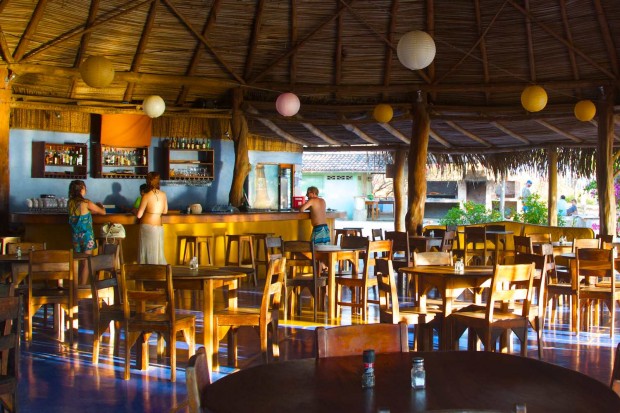
Viva Tropical
The hotel’s restaurant and bar are also located right on the beach. From 7:00 a.m. to 9:00 p.m. the kitchen serves up salads, burgers, tropical fruit platters, steaks, fresh seafood, sandwiches, and traditional Costa Rican cuisine. There’s also a weekly Argentinian barbecue, which guests love.
The bar stays open much later and offers fresh fruit smoothies, cocktails, margaritas, and other frozen libations. It’s the perfect place to sit a while or even an entire day, just relaxing under the thatch roof, watching the surfers, and conversing with other travelers from all over the globe.
In the evenings, people gather on the beach to watch the spectacular sunsets.
Hotel Playa Negra is the perfect place to get away from it all and enjoy an authentic tropical beach vacation, without having to compromise any of the creature comforts you’d get at other, more well-visited locales. Whether your interests include surfing, sunning, or just soaking up your surroundings, this is a destination that promises not to disappoint you or the family.

A discussion with off-grid specialist Eric Youngren, one part adventurer and one part alternative energy expert. Eric is the perfect person to talk about off-grid technology for Viva Tropical readers and listeners. With extensive experience in remote and third world locations we set out to learn some practical advice from a qualified person. Eric can install systems anywhere in the world which makes him a potential candidate for any project you might have.
Tune in and find out if off-grid living is worth it for you.
In this episode, we discuss:
- How do you know how much energy you need?
- What system is right for you?
- Is living off-grid hard?
- What do I need to know before considering getting off the grid?
And much more.
Listen to the show
You can listen to the show using the player above or grab it and listen on the go via one of the following options:
- Click here to download the mp3
- Click here to subscribe via iTunes
- Click here for the RSS feed (non iTunes)
- Click here for the show archive
React to the Show
We appreciate your reaction to episodes of Viva Radio and feedback about how we’re doing.
Send us your thoughts any time in an email or comment below.
The Show Notes
Everything you need to know that happened in the last 2 months in Belize.
Each day we sift through hundreds of articles in English & Spanish to bring you the very best ones from Central America.
From investment indicators to new infrastructure projects. Adventure stories to politics. It’s all here.
Belize June 2014.
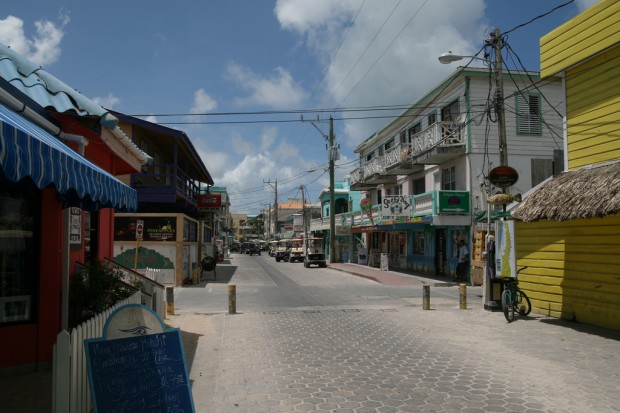
Bernt Rostad
Belize Lifestyle
- 5 Fun Things to Do in Belize this Summer 2014 (Breaking Belize News) Go from diving to caving in one summer with Breaking Belize News’ Top 5 Fun Things to Do in Belize this Summer of 2014.
- 10 Places We’re Meh About and Where to Go Instead (Huffington Post) Costa Rica is overrated. It’s been done and it’s time to find another gorgeous Central America location, so go visit Belize.

Fifth World Art
Belize Tourism
- Fishing Is Good in Waters Off Belize (Dallas News) South Water, part of the Belize Barrier Reef and the surrounding protected marine preserve, is home to some of the best fishing in Belize.
- Chabil Mar Resort in Placencia Belize Earns Fodor’s Choice Award (Communities Digital News) Fodor’s Travel has given the prestigious “Fodor’s Choice Award” for the best hotel in southern Belize to Chabil Mar, located in Placencia Belize. The award recognizes Chabil Mar as a leader in its field for service, quality, and value.
- In Belize, Relics of Ancient Past (Gulf Times) Not as famous as Mexico’s Chichen Itza, but the Mayan ruins of Xunantunich in western Belize are just as jaw-dropping spectacular.
- World’s Best Honeymoon Destinations for 2014 (AARP) AARP.com, has named Belize as one of the world’s best honeymoon destination for 2014. Belize was the only country in Central America that made it on the list.
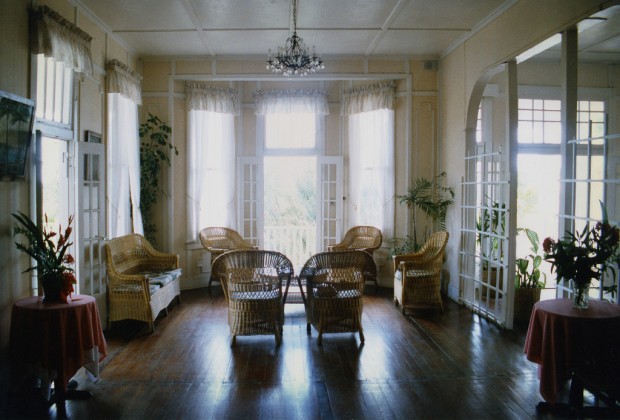
Anoldent
Belize Investment
- $10 Million from Taiwan to Belize (The Guardian) Taiwan’s Ambassador to Belize has pledged $10 million (US) to Belize for development in key infrastructural projects.
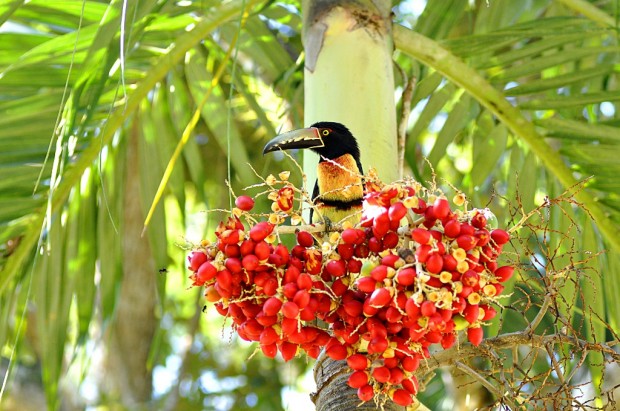
Theodore Scott
Belize Environment
- Minister Hulse Shocked by Thumbs Down Given to NCL Project (Belize News 5) Norwegian Cruise Lines wants a multi-million dollar tourism project in southern Belize. And the Belize government has all but given a green light to start, but it might be stopped before it even starts as the Belize Tourism Industry Association has filed a lawsuit against the Government of Belize.
- Leading Belize Eco-Resort Green Globe Certified (Global Travel Industry News) Xanadu Island Resort has received certification and recognition by Green Globe as a leading Belize Eco-Resort.
Like this country brief? Get it in your inbox weekly for free.
Be sure to catch the weekly country briefs by subscribing via email right here:














